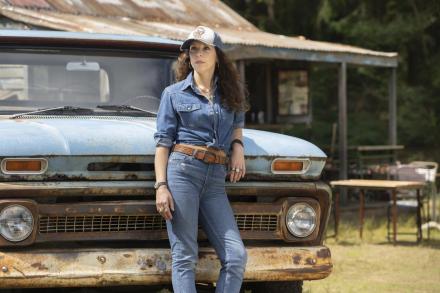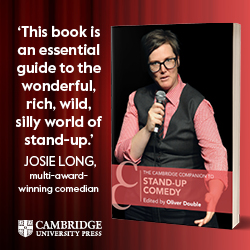
Bridget Christie’s The Change, produced by Expectation, returns to Channel 4.
The BAFTA-nominated comedy is created, written by, co-directed and stars the multi-award-winning stand-up comedian, actor, and writer Bridget Christie. Mackenzie Crook (Detectorists, The Office, Pirates of the Caribbean) also co-directed.
The star-studded cast returning to the Forest of Dean are Susan Lynch playing Eel Sister Agnes; Tanya Moodie playing DJ Joy; Liza Tarbuck playing Linda’s older, domineering sister Siobhain; Jim Howick as The Verderer; Jerome Flynn as Pig Man; Paul Whitehouse as Tony and Omid Djalili is back as Linda’s husband Steve. Laura Checkley (King Gary, Detectorists) joins the new series as Eel Sister Theresa.
At the start of series two, Linda (Bridget Christie) has got some explaining to do. Faced with the repercussions of the lies she’s told the forest community, along with losing the Mother Tree, and the arrival of husband Steve who has come to bring her home, Linda's future in the forest looks uncertain. But she’s already come a long way since being mother/wife/homemaker Linda Jane Jenkins of Swindon, and her journey is far from over. She may have only been Eel Queen for a day, but something’s changed in Linda which means she’s not done yet – in fact she’s only just started. But little does she realise what a huge impact this decision will have on the town…and Steve.
The Change, Tuesdays from March 25, 10pm, C4 and all avaiulable on C4 website now.
Bridget Christie Interview
What was your reaction to the response from fans and critics after the first series?
I was absolutely over the moon. It was incredibly humbling to see so many people take the show to their hearts, from women, and men, creating their own chore ledgers to women making their own folk-art headdresses. When you put something out into the world you’ve absolutely no idea how it will land. It doesn’t matter how hard you’ve worked on something, or for how long, that side of it is completely out of your control. All you can do is your absolute best, make something you would want to watch yourself, and hope that it resonates with people. So yes, we were all overwhelmed grateful and relieved by the love for the show, and for Linda!
When did the vision for series two start taking shape, and did you have a clear direction in mind from the beginning?
I’ve always seen The Change as a multi-series project so a lot of the ideas and themes for series two have been there since the beginning. I always knew I’d be delving further into Linda’s and the supporting characters’ backstories, running with the chore ledger idea, exploring the role of women in society, within both historical and modern contexts, and continuing to explore and include the natural world as a metaphor for humanity/community. In this series, I’ve used Pig Man’s wild boars’ truffles in order to shine a light on fungi, its vital role on the planet, and how we, as humans, might learn from its tenacity and collaborative processes in order to achieve contentment and purpose in life. A huge inspiration for me was reading Merlin Sheldrake’s Entangled Life: How Fungi Makes our Worlds, Change our Minds, and Shape Our Futures. So, where rebirth, reinvention and transition were major themes for series one, series two focuses on acceptance, mortality, and the cycle of life. Series two also focuses on the witch trials and asks the question, “What, or who, is a witch?”
Linda’s look this series has a distinct Americana vibe—denim, trucker caps. What was the decision behind that?
Linda’s new look reflects the internal journey she has gone on. She’s finding her confidence in series two, both mentally and physically. She’d never have worn a trucker’s cap and cowboy boots back home in Swindon, where she was invisible, where she bought her clothes in the supermarket along with the week’s groceries. Linda hasn’t thought about what she looks like or what she wears since she had children, but away from the distractions of home, she rediscovers that part of her identity is how she presents herself. When we first meet Linda at the start of series one, she is working at around 40-50% of her potential, and we had to start there in order to go on the journey with her. By the end of series two, she is certainly getting there – but is still not at full throttle.
In the opening episode, Linda is put on trial by the townspeople. Can you share more about the witchcraft themes woven into series two, and why you wanted to explore this aspect of the story?
I wanted to explore witchcraft themes in the series for a few reasons. Firstly, because even though we don’t put women on trial for witchcraft any longer, society is still judgemental, and fearful of, women who don’t easily fit into stereotypes. Women who challenge the status quo, and reject authority, who don’t fit, speak out, don’t have or want husbands or children, old women, are precisely the types of women who would have been put on trial and executed. It was an abhorrent and tragic miscarriage of justice, and one that I feel has not been appropriately acknowledged or apologised for. I also wanted to explore ideas around women’s intuition, our power and mystery, and how, instead of the word ‘witch’ being a derogatory term, it is in fact, a compliment to be called one, which is exactly what I told a misogynist bus driver earlier this year.
What parallels do you draw between the treatment of women during the witch trials and the way women are often portrayed today—especially in the media and on social media?
We haven’t moved on that much. You only have to put Elon Musk, Jess Phillips and ‘evil witch’ into a search engine to find the parallels.
As a woman, how important is it for you to use your comedy and writing to shed light on issues like emotional labour, the invisible workload, and the fight for women to have an identity beyond motherhood and wifehood?
I found that the older I got, the more I wanted, as an audience member or viewer, to be made to think as well as laugh, and so I started writing comedy about things that were important to me. But I’m not sure that as a woman I ever feel obligated to write about issues concerning women, but if women do feel seen and heard by the things that I talk about then that’s obviously great.
What is your standout scene from series two?
Can I have two? The silent supper scene in episode five and then Janet and Judith in the caravan asking Linda about the chore ledger from episode three.
Linda gets a tattoo in series two that says, "May all your transitions be joyful." Why does this resonate with you personally?
I’ve reached an age (53) where I’m aware of the passage of time and so try and live life to the fullest. Embracing change, it is essential to do this.
Linda speaks about the need for women to have an identity outside of just being a mother or wife. Why do you think this message is so important?
I think a basic fundamental human right for all people is to be allowed to inhabit, embody and retain who we are as individual human beings for the duration of our lives. It is only when we are allowed to do this that we can contribute the most to society.
After watching this series, what do you hope viewers take away from it?
I hope it inspires courage and hope, a zest for life, a women’s strike/chore revolution, a reclaiming of the word witch, and a passion for fungi!
If you could offer Linda one piece of advice for series two, what would it be?
No more tattoos!
Interview supplied by C4
Picture: Jon Hall/Expectation TV/Channel 4



